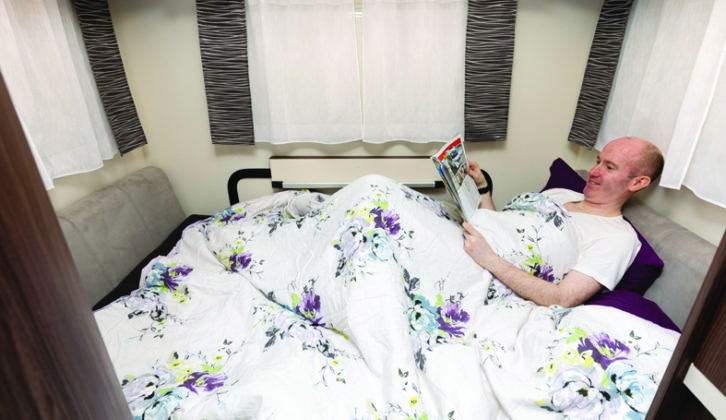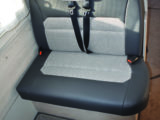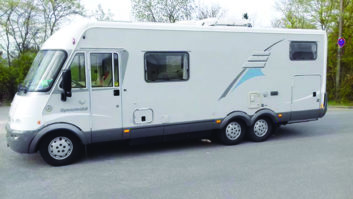SO, YOU’VE DECIDED to buy a motorhome or campervan. Congratulations! You’re entering a travel world of fabulous opportunities to get outdoors, enjoy camping, great road trips and more freedom than you’ve ever possibly known on holiday before. But before you sign up for the motorhome of your dreams, make sure you get one that’s right for you.
1 Who is travelling?
This is the most fundamental question you need to ask. It dictates what kind of layout you are going to need.
The days when passengers in the rear could swan about doing what they liked came to an end back in 1991, when wearing seatbelts in the back seats (if belts were fitted) became compulsory in the UK.
If there are going to be more than two of you travelling, you should ensure that you have enough belted forward- facing travel seats in the rear. This means that you’ll likely need to look at motorhomes with a rear dinette or full rear lounge (although some motorhomes have fold-away belted seats).
Also, don’t assume that because a motorhome is, say, a four-berth, it will necessarily have four travel seats. There are manufacturers who offer models with more than two berths, but that only have the two cab seats for travelling in.

The idea is that the extra passengers will travel in a separate vehicle. This is why some other manufacturers have started using the term ‘beds equals belts’ in their information, to make it clear to buyers what they’re getting.
Of course, you might feel you want to be flexible (isn’t motorcaravanning meant to be all about the spur of the moment?). Or you might think that a parallel settee arrangement is more comfortable on-site (usually, but not always, true).
So you might be tempted to go for motorhomes with foldaway travel seats in the rear. Bear in mind that the quality of these seats does vary, and they do take up what would otherwise be valuable storage space, whether they fold under the settee or dismantle so you can put the parts away. Some are tricky to set up, and when upright, aren’t as comfortable as the cab seats.
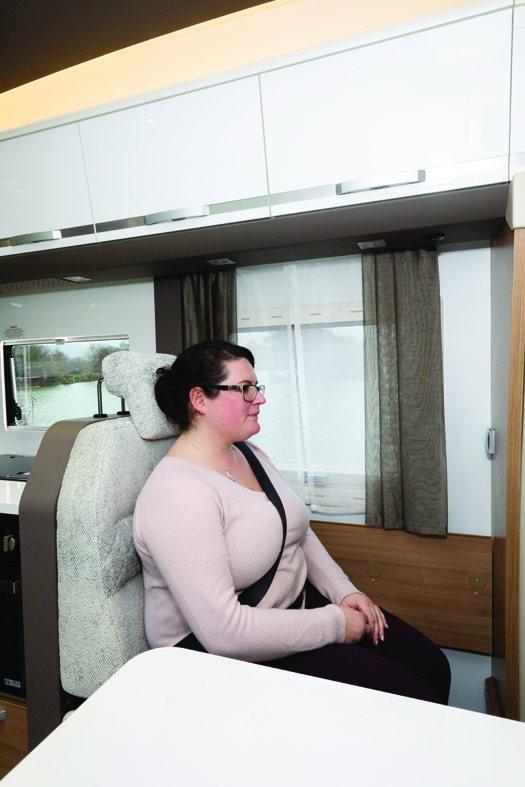
You might find that even permanent travel seats do not pass muster with older children. On long trips, these solid benches can prove a bit uncomfortable. This is why some manufacturers have started offering cab-style seating in the rear, too.
2 Will you be using your motorhome for anything else?
Buying a motorhome is a substantial investment, so some people try to lessen the impact by choosing a vehicle that they will also use in day-to-day life. Before you go for that, think what you mean by ‘day-to-day’.
If you mean only using the ’van occasionally as a means of transporting heavy items, you are still going to want a model with large, contained storage areas. With a low-profile or A-class, this could mean a sizeable garage.
For a van conversion, this will mean having a rear bed that you can easily dismantle to provide more storage space, while with a campervan, you might choose to opt for rear seats that slide forward on rails.
If, however, you really plan to use your motorhome every day, then you should opt for something a great deal smaller. Finding a parking place for a 7m-plus vehicle can be tricky; having to do it every day soon becomes tiring, especially if you don’t have a big enough driveway for it. Go for something no more than 6m long.
Some people like to disguise the fact that their vehicle is a motorhome at all. You can get some campervans with tinted windows (particularly Mercedes Vito conversions), which you could drive into the office car park on a Friday morning without anyone knowing you’ll be hitting the road come five.
3 Where will you be travelling?
If you think you will be doing most of your touring on the Continent and you live close to a Channel port, it might make sense to opt for a left-hand-drive model. There are dealers in the Home Counties who specialise in these.
This is especially pertinent with A-classes. At the moment, the only manufacturer selling A-classes in the UK with a sole driver’s door on the UK offside is Roller-Team. With all other manufacturers, us Brits have to put up with any sole opening door at the front being on the passenger side. This can become a touch frustrating, particularly at site barriers and car park entrances that still require tickets.
In addition, you need to bear in mind that most Continental models are designed primarily for a left-hand drive vehicle, and making the switch is not always successful.
For example, look out for motorhomes with the washroom near the front. When the cabs for these are switched over, there is sometimes not enough space for tall drivers to push the seat back.
Toilets, too, can end up being located surprisingly close to the door following a switch, so you might have to extract the cassette inside any awning.
4 When will you be touring?
If you plan to use your motorhome all year round, you should certainly check the insulation.
Most new motorhomes now come fitted with Grade 3 insulation, which is designed to show that they are suitable for this purpose.
The best insulation comes from your motorhome having a double floor. This necessarily means that it will be more expensive, but the double floor often also provides useful storage areas.
As for heating, most people doing all-year-round touring opt for the Alde wet heating system. While this does provide uniform heat, it takes a while to get going. If you are just after a quick blast of heat to ward off the chill, Truma blown-air heating should suffice, especially the Combi 6 system.
5 How do you like to sleep?
These days, more and more people are opting to have at least one fixed bed in their motorhome.
This is fine, but it’s important to ensure that in making space for such a bed, the designer has not left too little room for anything else.
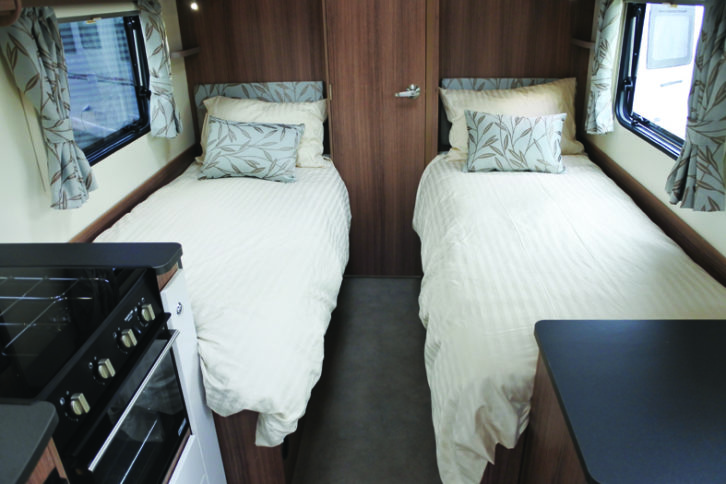
Generally, a transverse bed takes up the least length, followed by a French (corner) bed, although you only really avoid the problems of having to climb over your partner to get out of bed with either fixed singles or an island bed.
Fixed single, island and transverse beds can often be in a higher position to make more room for a garage below – in particular so that it can be high enough to take a conventional bicycle. This can sometimes make the beds more difficult to get into, and might feel claustrophobic (and hot, unless there is good ventilation).
It might be better to go for a model where the bed height can be adjusted, so it’s high when you are travelling, but lower on-site once everything has been unpacked.

Drop-down beds (usually transverse, sometimes longitudinal) are increasingly popular, either over the cab in A-class models, or over the front lounge. In the latter position they can often blot out an otherwise useful rooflight (common where they are fitted as a cost option, rather than standard), so you need to check that the lighting underneath them is adequate for the lounge. You should also make sure they do not obstruct the door too much.
Whether the beds go up or down manually or electronically largely depends on overall price. But even if you go for the luxury of electronic, make sure there is a manual override function. A ’van with a drop-down bed that is stuck in the down position could potentially be undriveable. And what would you do then if you were in, say, Morocco?
Non-fixed beds are usually put together by using a combination of pull-out platforms, a lowered table, and occasionally extra pieces of wood. Try to go for models where the bed is made up with the cushions that are already in place during the daytime. Infill cushions take up valuable storage space – as do backrests that have to be stowed away at night when they are not needed to make up the bed.
6 Will you be cooking much?
The chef pictured in the sales brochure may be whipping up a spectacular feast, but in real life, you are only ever likely to be putting together a relatively simple meal in your motorhome.
Many Continental models will also include a pull-out unit in the kitchen featuring a column of wire shelves. They’re a good space saver, but do tend to add to the number of rattles you are likely to hear emanating from the rear while you are on the road.
Most British motorhomes that you’ll find on the forecourt will have an oven already fitted, and even if you’re not interested in using one yourself, specifying an oven if you order a new ’van could help the resale value when it’s time to sell.
You’ll also want at least one mains socket for the kettle or the toaster in the morning. And, in our experience, motorhome cooking often involves reheating already cooked food, so a roomy fridge and a microwave are two items that you’re likely to want.
Besides dinner, don’t forget that while motorhomes are wonderful to wake up in for breakfast, they are also the perfect venue for an enjoyable lunch en route. You can just pull into a layby, swivel the cab seats and have a quick bite to eat without even having to get out of the vehicle. In such cases, you might find that a smaller pedestal table is more handy than a foldaway version that you have to haul out for use, and then stow away again afterwards.
7 Do you need a fancy washroom?

This is really only a question for those considering buying a larger motorhome, because with most campervans, you usually only get a Porta Potti. After all, some diehard fanatics claim that not having a washroom is precisely what makes a campervan a campervan!
Washrooms in general are rarely going to match the den of pampering you might have at home. Still, toilet blocks on British campsites can be rather variable, and you might find that your motorhome washroom is cosier than what is on offer outside.
Even if you don’t use the washroom very often, it can still serve as a useful place to leave wet coats to dry, or even to leave an awning if it hasn’t dried off by the time you are leaving for home.
Whether you decide to go for a separate shower cubicle will probably come down to how long a vehicle you can afford to have. If you do want the shower but need to compromise, there are new models with a Vario washroom – where a partition swings across the basin when it is not in use, to provide more room for the shower.
These are a good solution, although you’ll find that some models have little more than a rather flimsy plastic catch holding the partition in place. If that goes, you then have to deal with the potential problem of a heavy partition waving about whenever you are on the move.
8 Are you taking an awning?

Motorcaravanning is supposed to be all about get up and go, and for that reason, awnings aren’t quite as popular among motorhome owners as they are with caravanners.
They need some time to put up and take down, which might not seem worth it, and they are bulky to carry, especially if you only have a small campervan.
That said, they can provide a useful extension to your living area. If you know you are always going to take one, for example, you don’t need to worry so much about having too small a front lounge in the motorhome itself.
Drive-away awnings, which stay upright when you head off for the day, are a useful way of retaining your pitch when you return. This is an important issue when you are staying on busier campsites. Obviously you wouldn’t want to leave anything valuable in there.
If you are new to touring, you could try spending your first year without an awning, to see how you get on.
9 Are you taking a bike?
One rare advantage caravanners have over motorcaravanners is that, once you are on site and unhitched, you have a handy vehicle ready to take you for a quick trip to the nearest town.
It’s no surprise, then, that to speed up the walk into town (which always seems longer than the warden says) many ’van owners bring bicycles, particularly now that electric bikes are becoming more affordable.
Bikes will eat into your payload, however, so make sure you still have enough when they are included.
You also need to think about where you are going to stow them. A bike rack on the back of the motorhome is good, but it might interfere with your reversing camera, or make opening any rear door en route a bit tricky.
Stowing the bikes in the aisle inside is also an option, but it is sometimes difficult to harness them sufficiently here to stop them moving about.
If you have a garage fitted in your motorhome, make sure that it has a height of at least 1m, if you don’t want to have to dismantle your bikes, and has proper holding points to secure them while you are travelling.
A bonus is that the garage should mean you have somewhere safe to store the bikes when on site as well.
10 What’s the cab like?

Is it your view that, as long as you have a powerful enough engine to get you over those hills comfortably, you don’t need to think about the cab?
You could be right. But bear in mind that you will often spend more time in the cab during the day than you do in the front lounge. So you might want to consider things such as the position of the drinks holders. Some drivers find having them located above the dashboard, as they are in the Ford Transit, less distracting than having to feel down for them, as you have to in some Fiat cabs.
Cab air conditioning and a passenger airbag now frequently come fitted as standard. You might think those other extras, such as matching cab seats, that often come in options packs are not worth it, but they might well be worth considering, not least to keep up the resale value.
Check also for the provision of cab blinds – not having these is generally the sign of a budget motorhome, but you would be surprised how many models that you would not consider budget price only include them as an optional extra. Putting up independent blinds every night is a bit of a chore.
Get a quote for a motorhome now
How it works
We work with the UK’s best motorhome manufacturers to match your requirements with their products. Just tell us what you need from a motorhome and we’ll forward your details on to the most suitable ones. They’ll then contact you to see if you want to take things forward.
1. Enter your details below. Simply tell us a bit about what you want from a motorhome, and leave some contact details.
2. We search our database. We’ll match your requirements with the services and prices that our partners offer.
3. Partners will contact you. Only the suppliers who match your requirements will reach out to you.
Buying a motorhome is a substantial investment, so some people try to lessen the impact by choosing a vehicle that they will also use in day-to-day life.


